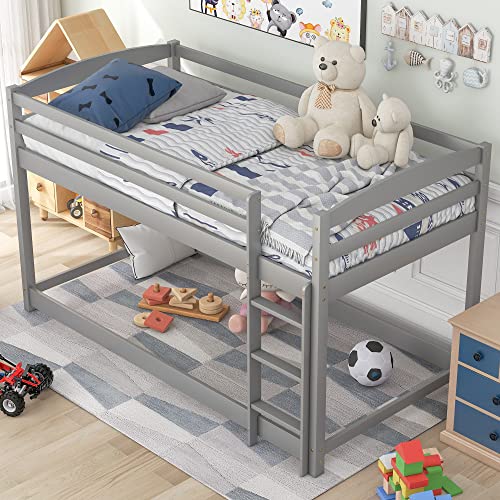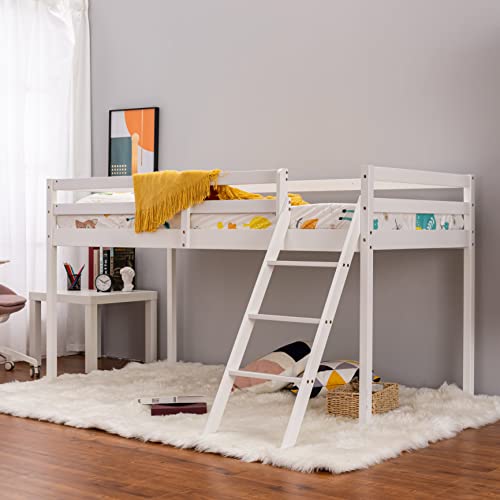Guide To Bunk Bed In Middle Of Room: The Intermediate Guide In Bunk Be…
관련링크
본문
 bunk Bed in middle Of room [http://www.daoban.org/space-uid-720283.html]
bunk Bed in middle Of room [http://www.daoban.org/space-uid-720283.html]For children sharing rooms, bunk beds are usually an excellent addition to the room. They are fun and add an attractive focal point to the bedroom.
Bunk beds work well in rooms that have architectural quirks, such as high ceilings with slopes, or in large bedrooms with enough space to accommodate the stacked arrangement. To ensure a good placement of bunk beds, you need to follow a few basic design guidelines.
Stores
There are a variety of clever ways to organize things in bunk beds. This will keep them off the floor and away from view. The addition of shelving units can be a simple and cost-effective option to store books, decorative items, or things that are normally stored on dressers or nightstands. Built-in closet systems can also be a great option to expand the storage space in your bunk bed. The closets can be designed to blend with your bedroom decor and provide the ideal space to hang clothes or put away toys and linens.
Consider incorporating shelves on the sides of your bunk bed to create an elegant solution. These shelves are a great place to store lamps for your midi cabin bed with desk, alarm clocks and other everyday necessities that are otherwise piled up on the floor or in dressers. They can also be used to display favorite framed photos and Knick-knacks. Also, you can consider incorporating storage drawers in the stairs of your bunk bed. They are ideal for bedrooms that are shared as they let each person store their personal belongings in a convenient location without compromising safety or integrity the staircase.
If you don't want to take on a DIY project, you can purchase already-made storage drawers suitable for all kinds of bunk beds. These drawers are a straightforward method to make the most of the space under your bed and are available at home improvement stores as well as online retailers.
You can also make storage space for Childrens Mid Cabin Bed your bunk bed by building cubbies along one wall. This whimsical shared bedroom is a great illustration. These are great to store backpacks, shoes or blankets to keep them from cluttering the other rooms. Hooks can also be used along the walls to hang hats, coats and other accessories.
Flow
This bunk bed design allows you to keep the layout of your child's room open. It also allows you to make use of the space below to create a practical bedroom storage solution, with clever drawers, shelving and cubby hole compartments. This is a fantastic idea for smaller spaces since it allows you to free the floor space to be used for other furniture for bedrooms or to create a unique playroom design.
If you put a bunk bed in the middle of a room it is crucial to think about how traffic will flow throughout the room. Make sure you leave enough space between the bunk bed and the door or closet. You could also consider installing an area rug to serve as a focal point to help anchor the room.
If you're concerned about safety, it's also important to consider the placement of the bunk bed relative to other furniture in the bedroom and the ceiling. It is important to be sure that the distance from the top bunk bed to the ceiling is not more than 24 inches, and that the distance between the lower bunk bed and the ceiling, is not more than 16 inches.
The frame of the bed and the way it's connected to the wall are the primary factors which determine if they'll sway. The bunks we offer are designed to meet mandatory and voluntary ASTM testing specifications and quality inspections, so they're designed to be safe and stable. However, a small movement or jiggle is normal and generally won't affect stability.
If you're concerned about your kids sleeping in close proximity to one another, it's recommended to think about purchasing a futon bed that provides each child with an individual space for sleeping and an individual ladder. This will also help avoid disputes or disagreements over who is allowed to sleep in the top bunk. You can also equip your children with comfortable ladders or steps for climbing up to the bunk. A night light should be put near the bunks so that they are more noticeable.
Design
For children who share the same room bunk beds are a fun way to maximize space. These beds are available in a variety of sizes and configurations, such as twin over full and queen over twin and even queen over king which makes them a flexible option for bedrooms with shared spaces.
If it is placed in the middle of the room A bunk bed can create an exciting focal point in a space. A bunk bed placed in the middle of a room can create a defined space for furniture such as workstations, study tables, and seating areas. When paired with a bold accent either on the wall or in a window seat this arrangement can create an inviting space for children to gather and play.
Bunk childrens midi cabin beds can be outfitted in amusing bedding or sporting memorabilia to reflect the character and preferences of the children who will be sleeping there. In this bunk room a mix of wood and metal bunks with sleek lines are a perfect match for an elegant interior palette. While patterns and bright pillows lend an eclectic feel The bunks' sleek lines and practical storage create a cohesive design.
In this lakefront home, a set of twin beds with full bunks is an uncluttered and functional place for children to play and sleep. The beds are made of white shiplap and wood and the linens are all blue to complement the color scheme of the room. Built-in niches in the bunks make a great place to store alarm clocks, books and even computers. A bright blue trunk adds color to the corner.
If you have enough floor space the bunk cabin bed mid sleeper in the middle of the room can make a cozy reading space for two kids. This bed comes with two twin beds that are the same as well as a built-in staircase that leads to the upper bunk. The upper bunk features an inviting headboard that is adorned with privacy curtains as well as a privacy curtain. This makes sleeping on the top of the bunk feel like a luxurious getaway.
If you're hesitant to put a bunk bed in the middle of your room, think about making use of room dividers as well as decorative elements to create a space that is purposeful and intentional. A large area rug, for example, can be used as a half-wall to separate the bunk beds from an activity area or sitting space.
Safety
Bunk beds in the middle of a room are an attractive design element but they also pose safety risks. Parents must supervise their children's sleep particularly on the top bunk and teach them how to use bunk bed safely. The majority of the injuries that occur in bunk beds result from poor use, not the bunk bed's structure or design. Bunk bed injuries can be prevented through regular maintenance and supervision.
Make sure the guardrails of a bunk bed are high enough to protect your child from falling off of the bed. The top bunk's height should be 30 inches or less from the floor, and the top bunk should have clearance of at five inches between the mattress and the guardrail.
If you're assembling the bunk bed yourself, make use of the tools supplied by the manufacturer to get the best results. Don't try to improvise or replace parts, as they could cause structural damage. After the bed is put together then gently shake it to test its stability. If the mid sleeper cabin bed with storage and desk seems unstable, it may be an indication that the connections need to tighten or strengthened. Make sure that the mattress platform is a snug fit and doesn't allow for sagging which could weaken the strength of the guardrails or ladder.
Teach your children how to use a ladder correctly. Ladders are only meant to be used for climbing up and down a bed. They should not be used for roughhousing or play. This increases the risk of injuries. It's also an excellent idea to set up an evening light near the ladder so that your children can see if they're climbing up or down at the night.
Keep the area around bunk beds free of any items that could harm. This includes scarves, belts, and ropes. These items can strangle children or cause other dangers. Bunk beds should not be positioned in a way that blocks doors or windows designated for escape during an emergency. This can make it harder to escape if you fall through a window, or are trapped in a small space.


